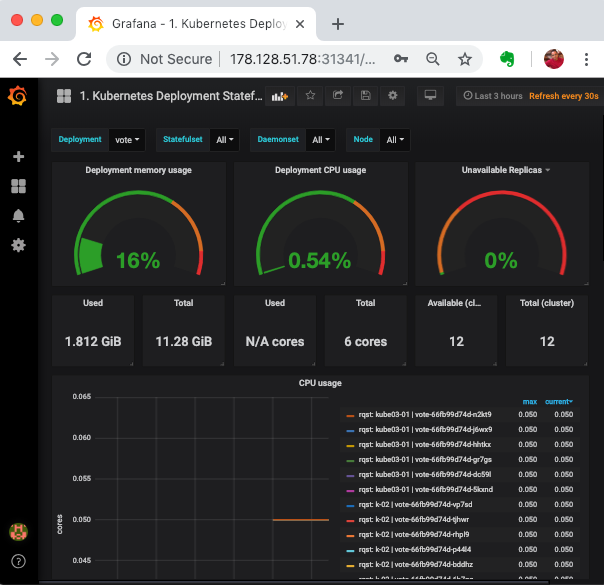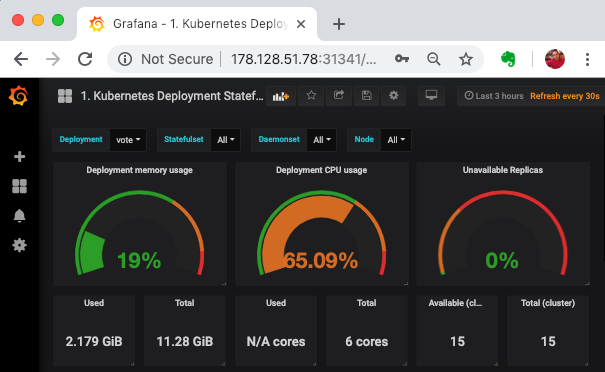Auto Scaling with Openshift
With Horizontal Pod Autoscaling, openshift automatically scales the number of pods in a replication controller, deployment or replica set based on observed CPU utilization (or, with alpha support, on some other, application-provided metrics).
The Horizontal Pod Autoscaler is implemented as a openshift API resource and a controller. The resource determines the behavior of the controller. The controller periodically adjusts the number of replicas in a replication controller or deployment to match the observed average CPU utilization to the target specified by user
Prerequisites
- Metrics Server. This needs to be setup if you are using kubeadm etc. and replaces heapster starting with kubernetes version 1.8.
- Resource Requests and Limits. Defining CPUas well as Memory requirements for containers in Pod Spec is a must
Deploying Metrics Server
openshift Horizontal Pod Autoscaler along with oc adm top command depends on the core monitoring data such as cpu and memory utilization which is scraped and provided by kubelet, which comes with in built cadvisor component. Earlier, you would have to install a additional component called heapster in order to collect this data and feed it to the hpa controller. With 1.8 version of kubernetes, this behavior is changed, and now metrics-server would provide this data. Metric server is being included as a essential component for kubernetes cluster, and being incroporated into kubernetes to be included out of box. It stores the core monitoring information using in-memory data store.
If you try to pull monitoring information using the following commands
oc adm top pod
oc adm top node
it does not show it, rather gives you a error message similar to
[output]
Error from server (NotFound): the server could not find the requested resource (get services http:heapster:)
Even though the error mentions heapster, its replaced with metrics server by default now.
Deploy metric server with the following commands,
cd ~
git clone https://github.com/kubernetes-incubator/metrics-server.git
oc apply -f metrics-server/deploy/1.8+/
Validate
oc get deploy,pods -n kube-system
Monitoring has been setup.
Fixing issues with Metrics deployment
There is a known issue as off Dec 2018 with Metrics Server where is fails to work event after deploying it using above commands. This can be fixed with a patch using steps below.
To apply a patch to metrics server,
wget -c https://gist.githubusercontent.com/initcron/1a2bd25353e1faa22a0ad41ad1c01b62/raw/008e23f9fbf4d7e2cf79df1dd008de2f1db62a10/k8s-metrics-server.patch.yaml
oc patch deploy metrics-server -p "$(cat k8s-metrics-server.patch.yaml)" -n kube-system
Now validate with
oc adm top node
oc adm top pod
where expected output shoudl be similar to,
oc top node
NAME CPU(cores) CPU% MEMORY(bytes) MEMORY%
vis-01 145m 7% 2215Mi 57%
vis-13 36m 1% 1001Mi 26%
vis-14 71m 3% 1047Mi 27%
Create a HPA
To demonstrate Horizontal Pod Autoscaler we will use a custom docker image based on the php-apache image
file: vote-hpa.yaml
apiVersion: autoscaling/v1
kind: HorizontalPodAutoscaler
metadata:
name: vote
spec:
minReplicas: 4
maxReplicas: 15
targetCPUUtilizationPercentage: 40
scaleTargetRef:
apiVersion: apps.openshift.io/v1
kind: DeploymentConfig
name: vote
apply
oc apply -f vote-hpa.yaml
Validate
oc get hpa
oc describe hpa vote
oc get pod,deploy
If you have a monitoring system such as grafana, you could also view the graphs for vote deployment.

Load Test
file: loadtest-job.yaml
apiVersion: batch/v1
kind: Job
metadata:
name: loadtest
spec:
template:
spec:
containers:
- name: siege
image: schoolofdevops/loadtest:v1
command: ["siege", "--concurrent=5", "--benchmark", "--time=10m", "http://vote"]
restartPolicy: Never
backoffLimit: 4
And launch the loadtest
oc apply -f loadtest-job.yaml
To monitor while the load test is running ,
watch oc top pods
To get information about the job
oc get jobs
oc describe job loadtest
To check the load test output
oc logs -f loadtest-xxxx
[replace loadtest-xxxx with the actual pod id.]
[Sample Output]
** SIEGE 3.0.8
** Preparing 15 concurrent users for battle.
root@kube-01:~# oc logs vote-loadtest-tv6r2 -f
** SIEGE 3.0.8
** Preparing 15 concurrent users for battle.
.....
Lifting the server siege... done.
Transactions: 41618 hits
Availability: 99.98 %
Elapsed time: 299.13 secs
Data transferred: 127.05 MB
Response time: 0.11 secs
Transaction rate: 139.13 trans/sec
Throughput: 0.42 MB/sec
Concurrency: 14.98
Successful transactions: 41618
Failed transactions: 8
Longest transaction: 3.70
Shortest transaction: 0.00
FILE: /var/log/siege.log
You can disable this annoying message by editing
the .siegerc file in your home directory; change
the directive 'show-logfile' to false.
Now check the job status again,
oc get jobs
NAME DESIRED SUCCESSFUL AGE
vote-loadtest 1 1 10m
- Keep monitoring for the load on the pod as the job progresses.
- Keep a watch from grafana as well to see the resource utilisation for vote deployment.
- You should see hpa in action as it scales out/in the vote deployment with the increasing/decreasing load.

Summary
In this lab, you have successfull configured and demonstrated dynamic scaling ability of openshift using horizontalpodautoscalers. You have also learnt about a new jobs controller type for running one off or batch jobs.